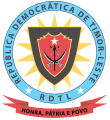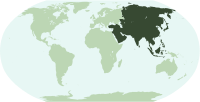Coat of arms of East Timor
| Coat of arms of East Timor | |
|---|---|
 | |
| Details | |
| Armiger | Democratic Republic of Timor-Leste |
| Adopted | 2007 |
| Escutcheon | On the centre of the coat of arms, there a curved pyramid with red edges and black core, symbolise Mount Ramelau, the highest peak in Timor Leste. On the black field in the centre there is a five-pointed star with five rays of light. Under it there is an open red book rest upon a yellow industrial gear. On the left side there is a rice ear (hare fulin) and on the right side there is a corn ear (batar fulin). Under the industrial gear there is an AK-47 assault rifle, bow and arrows (rama inan). Under the Mount Ramelau there is a ribbon banner written in Portuguese: "Unidade, Acção, Progresso" ("Union, Action, Progress"). Around the emblem there is a circle band written with the official name of the state in Portuguese: "República Democrática de Timor-Leste" (Democratic Republic of East Timor), and the acronym is written under "RDTL". |
| Motto |
Unidade, Acção, Progresso "Union, Action, Progress" |
The coat of arms of East Timor (officially: Timor-Leste) was introduced on 18 January 2007 under the Law 02/2007. It is based on a design first used when the country unilaterally declared independence on 28 November 1975.
The motto in Portuguese is "Unidade, Acção, Progresso" ("Unity, Action, Progress").
Description
On the centre of the coat of arms, there a curved pyramid with red edges and black core, symbolise Mount Ramelau, the highest peak in Timor Leste. On the black field in the centre there is a five-pointed star with five rays of light. Under it there is an open red book rest upon a yellow industrial gear. On the left side there is a rice ear (hare fulin) and on the right side there is a corn ear (batar fulin). Under the industrial gear there is an AK-47 assault rifle, bow and arrows (rama inan). Under the Mount Ramelau there is a ribbon banner written in Portuguese: "Unidade, Acção, Progresso" ("Union, Action, Progress"). Around the emblem there is a circle band written with the official name of the state in Portuguese: "República Democrática de Timor-Leste" (Democratic Republic of East Timor), and the acronym is written under "RDTL".
Previous emblems
Portuguese colonisation (1935–1975)
The arms of Portuguese Timor followed the same format of other Portuguese colonies (later overseas provinces) with the territory being represented by the black and white Dominican cross in recognition of the role played by the Dominican Order in converting the East Timorese to Roman Catholicism.[1]
Indonesian occupation (1975–1999)
Indonesia invaded East Timor in 1975 and annexed it the following year as its 27th province of Timor Timur. During this period, Timor Timur had its own coat of arms which remained in use until Indonesia rescinded its annexation in 1999. The arms consisted of a golden shield containing wreaths of wheat and cotton enclosing a blue roundel containing a stylised traditional East Timor house. This was surmounted by a blue shield depicting a gold star representing the faith in one God. Below the roundel appeared a traditional Timorese headdress (Kaibauk) bearing the inscription "Timor Timur".
United Nations Transitional Administration in East Timor (1999–2002)
The seal used by the United Nations Transitional Administration in East Timor (UNTAET) depicted an outline of the island of Timor, a crocodile, traditional head-dress and tais patterns. The seal included the words Timor Lorosa’e and Governu in Tetum or Timor Leste and Governo in Portuguese.
First coat of arms (2002–2007)
The first coat of arms contains the shield of the Conselho Nacional de Resistência Timorense (National Council of Timorese Resistance). The main elements are two crossed Suriks (traditional Timorese swords), together with a spear, a star, and two arrows. The country's title, in Portuguese, is on a blue ring around the shield and a sun with 14 rays. The motto in the banner translates as: "Honour, Homeland, and People".
Gallery
-
.svg.png)
Coat of arms of East Timor during Portuguese rule between 8 May 1935 – 11 June 1951.
-
.svg.png)
Coat of arms of East Timor during Portuguese rule between 11 June 1951 – 28 November 1975.
-

Lesser coat of arms of East Timor during Portuguese rule (1935–1975)
-

Coat of arms of East Timor during Indonesian rule (1975–1999)
-
.svg.png)
Coat of Arms East Timor during United Nations administration (1999-2002)
-

First coat of arms of East Timor (2002–2007)
